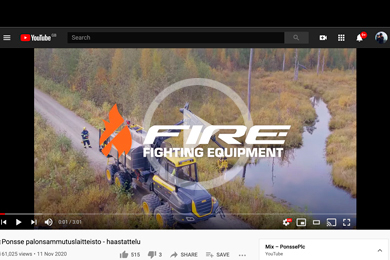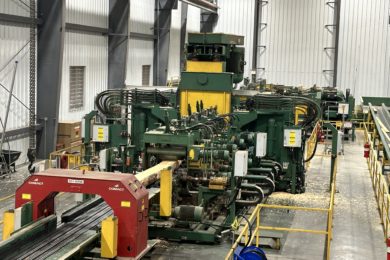The importance of wildfire suppression and effective firefighting measures has increased globally. In recent years, human activities and global warming have increased wildfires in all parts of the world.
Making use of the properties of forest machines
Finnish forest machine company Ponsse Plc, together with rescue departments, has developed firefighting equipment installed in the load space of a forwarder for fighting wildfires.
As wildfires usually take place far away from roads, accessing fire sites by fire trucks may be impossible or at least slow. Instead, a forest machine is designed to be agile in the terrain, and it can reach its destination quickly and easily, also in difficult conditions. Rescue workers normally carry fire hoses to wildfire sites manually or using an ATV and then connect a sufficient number of hoses together to reach the fire. It is easier to limit a fire and protect residential areas when using a forest machine than manually.
“Forest machines are the most natural and effective way to access a forest fire area. Operations in difficult terrain are second nature to them, and they have more than enough capacity in their hydraulic system for demanding conditions”, says Juha Haverinen, forwarder product manager at Ponsse. “When the rescue authorities asked us if we were willing to start developing this product together, we were ready right from the beginning, because rescue professionals and our customers round the world had a clear demand for firefighting equipment”, Juha says.
Firefighting equipment is available for the PONSSE Buffalo, PONSSE Buffalo King, PONSSE Elephant and PONSSE Elephant King forwarders. The minimum loader requirement is PONSSE K90+. The optional equipment is available for new forest machines, or it can be retrofitted on forwarders of the 2015 model series or newer.
A thoroughly considered technical system
The firefighting equipment designed by Ponsse is brought to the fire site on a transport base by a truck with a demountable platform, from where it is lifted into the load space of a forwarder using the forwarder’s loader. After the firefighting equipment is securely fastened and the electrical and hydraulic connectors are connected, fire suppression and fighting can begin.
“Our firefighting equipment consists of a 10 m3 water tank, which can be filled with the system’s powerful pump from a natural source, such as the sea, a stream, lake or ditch, or from the tank of a fire truck if possible. The water cannon has a range of 47 metres and a turning radius of 360 degrees”, Haverinen says, and specifies that when filling the water tank, a safe distance of 20 metres from the forwarder must be maintained.
The powerful pump fills the water tank very quickly, in just six minutes. At full power, it takes roughly 10 minutes to empty the tank when extinguishing a fire. The maximum speed of a forwarder is 20 km/h on public roads and 5 km/h in the terrain. This must be considered especially when the tank is filled from the tank of a fire truck, because large volumes of water must be transported to the site.
The water cannon and a fire hose can be used simultaneously. Using the remote control, a firefighter can adjust the water pressure, water cannon direction, spray angle and pattern (water mist or solid stream), whereas the water cannon’s water flow is adjusted manually. During firefighting activities, the forest machine and rescue personnel can be protected from heat radiation using a water mist pattern.
“The water tank is made from aluminum to make it as light as possible. In terms of its volume, the water tank is designed to fit the load space of a PONSSE forwarder, and it can be lifted into place using the forwarder’s loader. Aluminum is highly resistant to the use of chemicals mixed with water and the use of salty sea water. Baffle plates have been installed inside the tank to prevent water from moving freely in the tank when the machine is driven in the terrain”, Haverinen says.
To prevent corrosion damage, the equipment must be maintained regularly, especially if water is pumped from natural sources, as sand or other material may then access the tank. It is also important to clean the water tank thoroughly after the use of chemicals or sea water in the tank. Pumps must be protected against freezing when the equipment is stored in cold conditions.
Financially viable
Installing firefighting equipment on a forest machine is financially viable. A forest machine contractor who enters into a firefighting agreement can carry out productive harvesting activities in the forest when the firefighting equipment is not needed.
“In practice, this means that a rescue department owns the firefighting equipment, and it is stored on a transportation platform at the fire station. Rescue departments sign agreements with local forest machine contractors on the use of forest machines in firefighting activities. When there is a fire alarm, rescue personnel transport the firefighting equipment to the fire site and the forest machine contractor drives their forwarder there. Then, they can start firefighting activities together”, Haverinen says.
Local rescue department responsible for planning firefighting activities
Trained rescue personnel are always responsible for limiting and extinguishing fires, as well as supervising firefighting activities. The firefighting equipment is controlled by a firefighter, while the forest machine operator follows the instructions given via a radiophone. The forest machine operator does not require any rescue training to enter into an agreement on firefighting activities.
The firefighting equipment includes a wireless reversing camera. It is installed on a forwarder as optional equipment so that the operator can see behind the equipment. This ensures the safety of rescue personnel around the forest machine. The reversing camera is also necessary when setting the grapple in the transportation position.
The firefighting equipment meets the requirements of EU Machinery Directive 2006/42/EC. Before any delivery of the firefighting equipment to market areas outside the EU, it must be ensured that the equipment meets local requirements and regulations.







